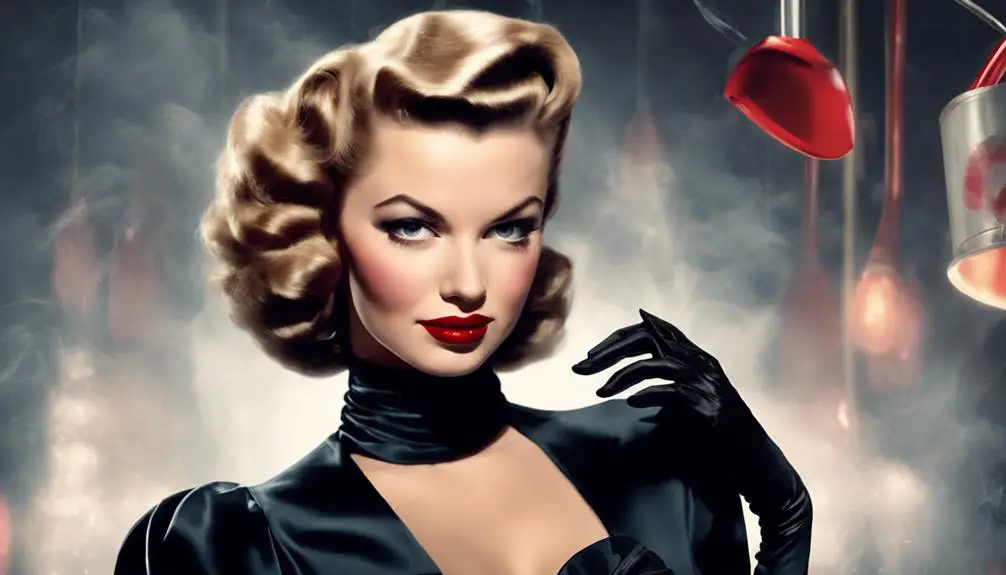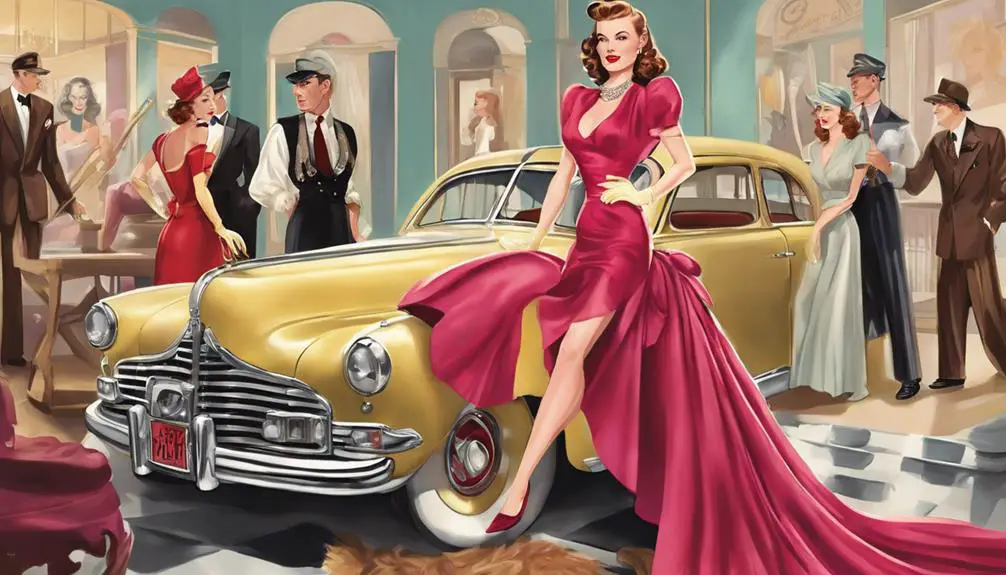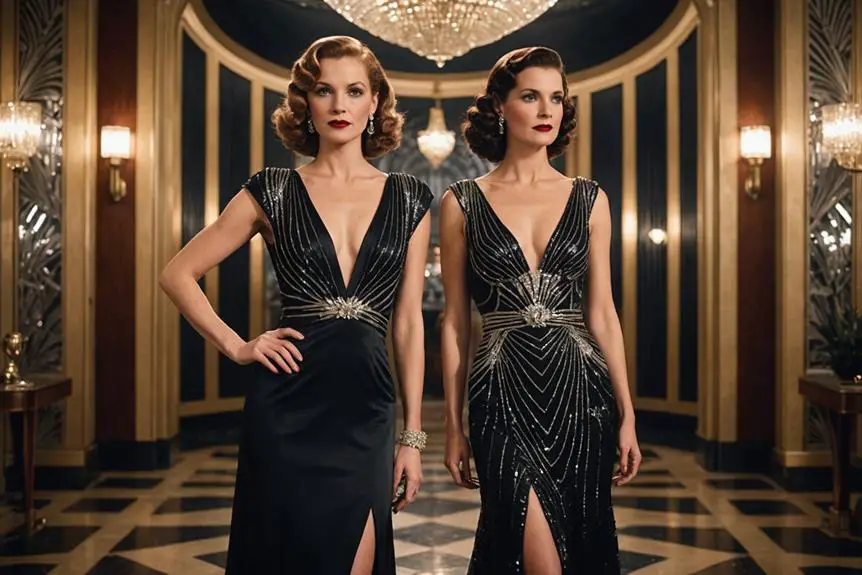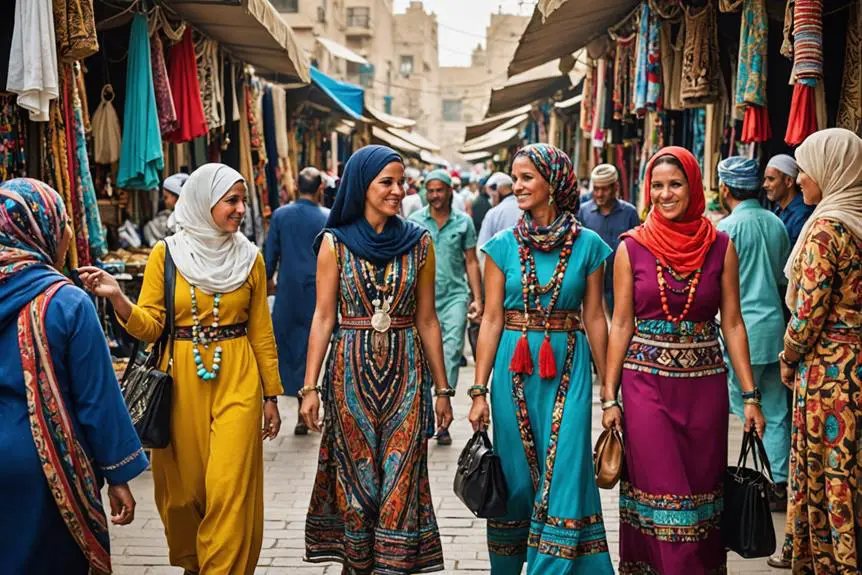It's a coincidence that as you explore the world of classic cinema, you stumble upon Gilda's iconic outfits, which are as enchanting today as they were in the 1940s. Each costume, from the sultry black satin gown to the striking gaucho attire, serves not just as wardrobe but as a narrative device that unfolds Gilda's complex character. You might wonder how these fashion choices influenced not only the film's narrative but also the broader cultural landscape. What can these timeless pieces teach us about style and identity in cinema?
Overview of Gilda's Character

Gilda, played by Rita Hayworth, is the ultimate femme fatale, enchanting viewers with her complex blend of desire and independence. You can't help but be drawn in by her magnetic presence. As a character, Gilda embodies the enchanting yet chaotic world of Film Noir, where nothing is quite what it seems. She's trying to escape her tumultuous past as a showgirl while maneuvering complicated relationships with Johnny Farrell and Ballin Mundson.
The emotional state of Gilda shifts dramatically throughout the film, reflecting her struggles and desires. At first, she appears confident and assertive, but as the story unfolds, you see her vulnerability. It's like peeling back layers of an onion—each layer revealing more about what drives her. Rita Hayworth's portrayal is mesmerizing, showcasing the character's evolution through her interactions and the choices she makes.
Now, let's talk about those stunning gowns designed by Jean Louis. They're not just clothes; they symbolize Gilda's emotional journey. Early on, you'll see her in alluring outfits that scream seduction. But as her character develops, her wardrobe becomes more structured, mirroring her quest for agency and self-worth. It's fascinating how her outfits reflect her inner turmoil and growth, isn't it? Gilda's story is a rollercoaster of emotions, and that's what makes her such an unforgettable femme fatale. You can't help but root for her, even when she makes questionable choices!
Iconic Outfits and Their Impact
Fashion plays a pivotal role in enhancing Gilda's character and the film's narrative, with each outfit serving as a reflection of her emotional state and journey. You can't talk about Gilda without mentioning the iconic black satin gown worn by Rita Hayworth during the unforgettable "Put the Blame on Mame" performance. This stunning dress not only screams 1940s glamour, but it also lets Gilda move with confidence and flair. How cool is that? The era's fashion trends, much like those in vintage Versace, highlight how clothing can convey deeper meanings related to character and context.
Gilda's wardrobe, designed by Jean Louis, includes a whopping 29 costumes, showcasing a huge investment of around $60,000. Talk about commitment! Each piece, from the frilly white chiffon negligee to the structured evening dresses, beautifully highlights her character's complexity. One moment she's sweet, the next she's seducing everyone in sight. It's like she's a walking contradiction, and her outfits nail that vibe perfectly.
Don't forget the Western-inspired Carnival outfit. This look marks a significant turning point in the film, symbolizing Gilda's inner turmoil and hinting at the dramatic twists to come. It's like a fashion prophecy!
Gilda's glamorous wardrobe didn't just stay in the movie; it influenced 1940s fashion trends and solidified Rita Hayworth as a Hollywood fashion icon. So, next time you see that black satin gown, remember—it's not just fabric; it's a part of Gilda's story, her struggles, and her triumphs. Isn't that just fabulous?
Costume Design Techniques

When it comes to costume design in "Gilda," Jean Louis really knocked it out of the park. He created 29 stunning costumes for Rita Hayworth, helping her transform into the iconic character we all adore. One of the standout pieces is the strapless black satin gown, which was engineered to defy gravity—seriously, how cool is that? Inspired by John Singer Sargent's famous painting "Madame X," this dress not only looked amazing but also allowed Rita to move freely during her performances. This innovative approach to costume design parallels the adaptability seen in brands like Dickies, which have evolved their products to cater to various industries and cultural shifts over the decades, including embracing streetwear.
Now, let's talk about the Amado Mio gown. It featured high side slits and clever coverage, balancing sensuality with the restrictions of the Hays Code. Jean Louis really knew how to navigate those tricky guidelines! He also incorporated practical details like harness support in the gowns to guarantee Rita could nail her complex dance routines without any wardrobe malfunctions, especially during that unforgettable striptease scene.
And don't forget about the lighting and camera angles! They played a huge role in making the costumes pop. With the black-and-white cinematography, the textures of the fabrics stood out beautifully, adding to Gilda's ethereal presence. It's like the costumes weren't just clothes; they were part of the storytelling, enhancing the whole vibe of the film. So, how can you not appreciate the innovative design techniques that brought Gilda to life? It's a masterclass in costume design!
Symbolism in Fashion Choices
Within the world of "Gilda," the costumes serve as powerful symbols that reflect the character's inner struggles and transformations. Take Gilda's gaucho costume, for instance. When she wears it at the carnival, it hints at her complex identity, revealing a superficial façade that foreshadows the conflicts she'll face. Then there's the iconic black satin dress, which embodies her seductive power but also her emotional turmoil. It shows that beneath her glamorous wardrobe, Gilda battles vulnerability and strength throughout the film.
As Gilda's story unfolds, you'll notice her evening wear becomes more structured and less sensual after her marriage. This shift symbolizes a change in her independence and personal freedom. Isn't it fascinating how clothes can tell such deep stories? The contrast between Gilda's glamorous outfits and her tumultuous love-hate relationships emphasizes her yearning for freedom, especially during that memorable taxi cab scene. You can almost feel the tension!
The costumes designed by Jean Louis not only enhance Gilda's allure but also visually narrate her character transformation. Each piece she wears tells you something about her journey through love, betrayal, and empowerment. So, next time you watch "Gilda," pay attention to those costumes. They're more than just fabric; they're a window into Gilda's soul. Isn't it amazing how fashion can speak volumes?
Cultural Legacy of Gilda's Style

Gilda's style has left an indelible mark on fashion history, with her iconic black satin gown and dazzling evening wear epitomizing 1940s glamour. When you think of Rita Hayworth, it's hard not to picture that stunning gown, right? Designed by the talented costume designer Jean Louis, Gilda wore 29 unique outfits that didn't just look fabulous; they told her story. Each piece reflected her emotional journey, transforming from a seductive femme fatale to a powerful woman as the film progressed.
Gilda's fashion choices became a cultural reference point, influencing how we view femininity and empowerment even today. Those gorgeous gowns and sharp daywear aren't just costumes; they're symbols of her strength and complexity. Have you ever noticed how her outfits seem to capture every mood? From sultry to sophisticated, they highlight her character's depth in a way that keeps you hooked.
Even now, you can see Gilda's influence in modern trends. Designers pull inspiration from her iconic fashion, reminding us that true style never goes out of fashion. It's pretty amazing to think that a film from the 1940s still resonates with us, right? Whether you're dressing up for a special occasion or just want to channel some vintage vibes, Gilda's looks are a perfect guide. So, why not embrace that 1940s glamour and add a touch of Gilda to your wardrobe? After all, who wouldn't want to feel like a Hollywood star?
Frequently Asked Questions
Who Designed the Costumes for Gilda?
You'll find that the enchanting costumes were crafted by designer Jean Louis, whose fabric choices and color palette reflected character symbolism and historical context, creating iconic looks that left a lasting cinematic impact and fashion influence.
What Color Was Rita Hayworth's Dress in Gilda?
Rita Hayworth's dress in Gilda showcases an iconic wardrobe, primarily featuring a striking black satin color. This vintage style captures Hollywood glamour, emphasizing color symbolism and dress details that enhance character representation and film aesthetics beautifully.
Did Rita Hayworth Really Sing in Gilda?
You might think Rita's singing in "Gilda" was her own, but behind the scenes, film dubbing meant her vocal performance was actually Anita Ellis. Ironically, Rita's acting skills turned iconic scenes into unforgettable musical contributions, enchanting audience reactions.
Why Was the 1946 Film Gilda Notable?
The 1946 film "Gilda" stands out in film noir for its iconic performances, particularly by Rita Hayworth. It reflects cultural impact and Hollywood glamour, establishing the femme fatale archetype, and has an enduring legacy in post-war cinema.




